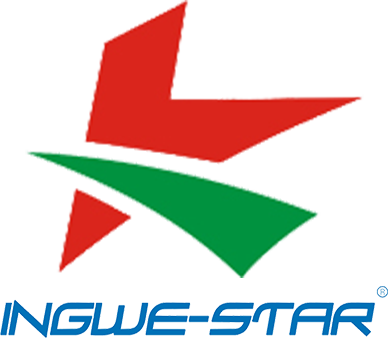How to Access Rebates for Energy-Efficient LED Lighting in 2025
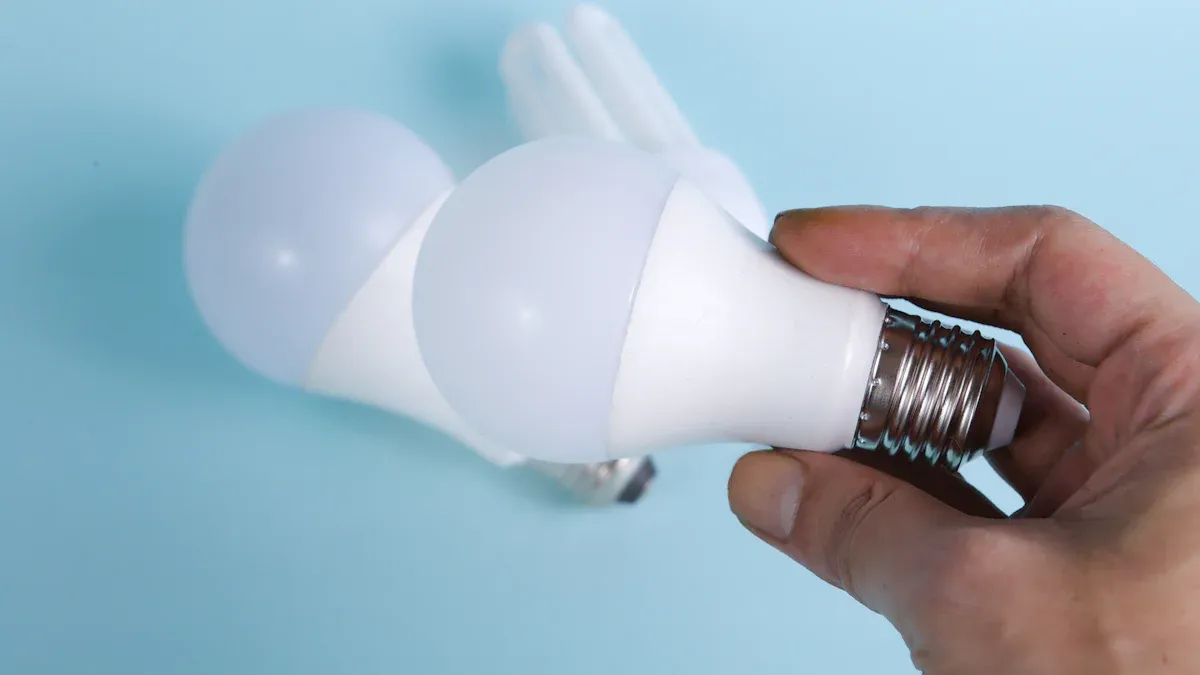
You can get rebates for energy-efficient LED Light upgrades in 2025. Use new LED Lighting Programs for homes and businesses. Rebates are now 3% higher than last year. This increase has happened for a few years. There are many new incentives. Some come from Efficiency Maine, Georgia Power, and federal tax credits.
Incentive Type | Description |
|---|---|
Efficiency Maine | Gives rebates for LED fixtures and networked lighting controls. |
Georgia Power | Has good rebates for commercial lighting retrofits. |
California’s Energy Star program | Helps upgrade to energy-efficient LED lighting in commercial buildings. |
Consumers Energy | Offers big incentives for LED lamps and fixtures. |
Energy Trust of Oregon | Gives rebates for lighting controls and better lighting systems. |
Federal Tax Incentives | Includes a tax deduction for energy-efficient lighting upgrades in commercial buildings. |
Act before deadlines like December 31, 2025, to save money. Go to the About Us or Product pages for more information. |
Key Takeaways
Rebates for energy-efficient LED lighting are offered in 2025. You should act before December 31, 2025, to save more money.
Federal and state programs give big rebates. Look at local programs for more details and to see if you qualify.
Use instant incentives to save money right away when you buy LED lights. These need less paperwork and give you fast discounts.
Plan your lighting upgrades early. This helps you finish on time and get the best rebates.
Make sure your LED products are ENERGY STAR or DLC-certified. This helps you get rebates more easily.
Find Rebates

Federal Programs
Federal rebate programs can help you save money in 2025. These programs give bigger rebates than last year. You might get $0.50 to $2.50 for each bulb you upgrade. The federal tax credit can be up to $3,200 for energy-efficient lighting. You must follow these steps to qualify:
Pick energy-efficient lighting.
Choose products that can get rebates, like high-efficiency LED lamps.
Look at your local program for the rules.
Change old lighting systems.
Fill out all needed paperwork.
Get pre-approval and plan inspections if needed.
Finish installing before the deadline.
Make sure your utility company is part of the program.
Keep all your documents for the final step.
Tip: You need to finish your installation and paperwork before December 31, 2025. Federal rebates have deadlines, so act fast.
State Incentives
Many states have their own LED Lighting Programs. Colorado has choices for homes and businesses. You can see more details in the table below:
Company Name | Area | Rebate Details |
|---|---|---|
Energy Smart Colorado | Aspen through Glenwood Springs | Up to $1,000 per household for upgrades; rebates are capped at 50% of the project cost. |
Energy Smart Colorado - Yampa Valley | Routt & Moffat Counties | $10 for each LED Replacement Bulb; up to 10 bulbs. |
Energy Smart Colorado | Eagle County | Incentive matches utility incentive up to $1,000; covers many LED upgrades. |
Energy Smart Colorado | Yampa Valley | $10 for each LED Replacement Bulb; up to 10 bulbs; $500 max rebate per customer each year. |
TVA EnergyRight helps people and businesses in the Tennessee Valley. These programs make it easy to upgrade lighting and save money. Always check your state’s website for new LED Lighting Programs and deadlines.
Utility Offers
Local utility companies give rebates for many LED fixtures. You can see common rebate amounts in the table below:
Fixture Type | Rebate Amount |
|---|---|
2x4 Fixture (DLC Standard or Premium) | |
2x4 Fixture w/ Occ Sensor (DLC Standard or Premium) | $65 |
2x4 Fixture w/ Dual Sensor (DLC Standard or Premium) | $70 |
2x4 Fixture w/ LLLC (DLC Standard or Premium) | $90 |
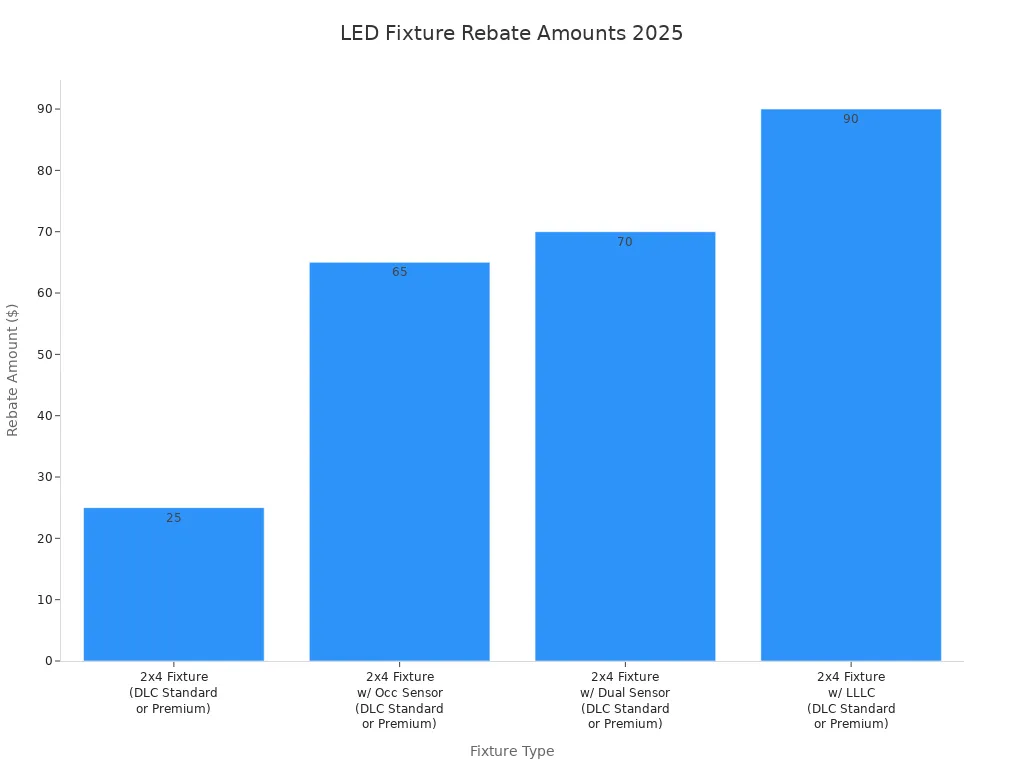
Utility rebates help you pay less when you upgrade to high-efficiency lighting. Some programs work with LED Lighting Programs for more savings. Ask your utility company about bonus incentives and deadlines.
Instant Incentives
Instant incentives give you savings right away when you buy LED lighting. You do not need to fill out lots of forms or wait for approval. These offers are popular with businesses and homeowners. You can see common instant incentive amounts in the table below:
Product Type | Rebate Amount |
|---|---|
Decorative lamps (<310 lumens) | $6 per lamp |
Screw-in HID LED – mogul base (≤100W) | $25 per lamp |
Screw-in HID LED – mogul base (>100W) | $55 per lamp |
Screw-in HID LED – medium base | $25 per lamp |
4-pin base LED | $10 per lamp |
2-pin base LED | $10 per lamp |
Interior Fixtures (DLC-listed) | |
0–60W | $20 per fixture |
60–120W | $50 per fixture |
120–200W | $100 per fixture |
200–300W | $180 per fixture |
300–500W | $350 per fixture |
Exterior Fixtures (DLC-listed) | |
0–60W | $25 per fixture |
60–120W | $60 per fixture |
120–200W | $120 per fixture |
200–300W | $225 per fixture |
300–500W | $375 per fixture |
Linear Products (TLEDs) | |
T8, T5, U-bend, 2–8 ft | $6 per lamp |
T5 HO (4 ft only) | $6 per lamp |
Other TLEDs | $6 per lamp |
TLED signage | $6 per lamp |
TLED Type C | $10 per lamp |
Exit Signs | |
Retrofit hard-wired LED exit sign kits (<5W) | $20 per kit |
Retrofit screw-based LED exit sign lamps (≤5W) | $5 per lamp |
LED T-1 or electroluminescent signs (≤5W per face) | $5 per sign |
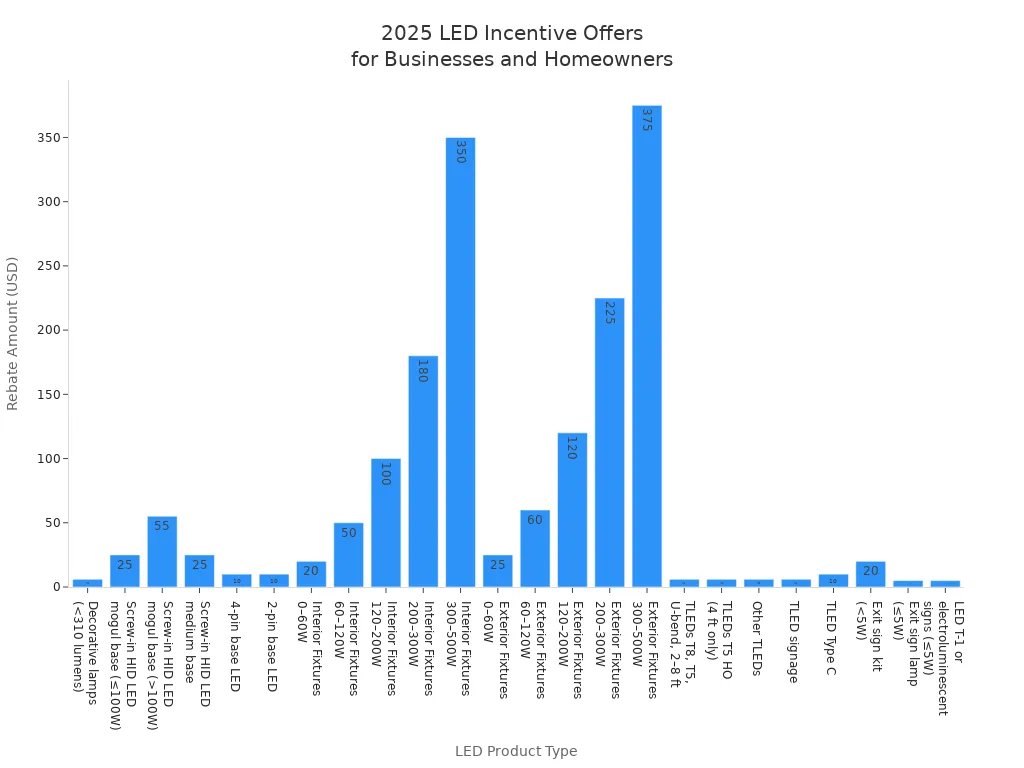
Instant incentives are given when you buy LED lighting.
You save money right away.
Traditional rebates need more paperwork and waiting.
Instant incentives do not ask for details about your old lighting.
You can use instant incentives with other LED Lighting Programs for more savings.
Note: Instant incentives are changing. More programs now help with LED-to-LED upgrades. You can talk to lighting professionals to find all the offers.
LED Lighting Programs
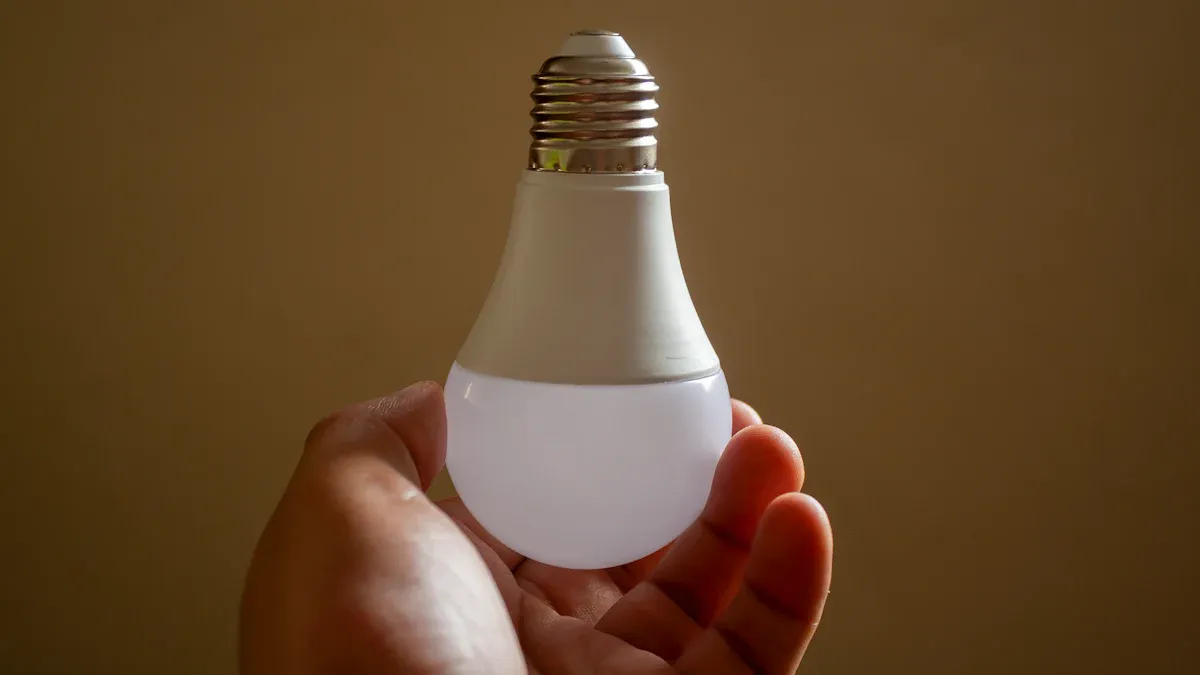
Eligibility
You must meet some rules to join LED Lighting Programs in 2025. Every program has its own steps. Most programs use the same process. Watch out for deadlines and extra rewards. Many programs run from October to September. You can apply any time in the year. You need to send your application by the last business day each month. Try to send it by June 30th to avoid waiting. After your lighting project is done, you have 30 days to send final papers. Some programs, like Oncor, close in November or when money is gone. CenterPoint Energy checks money in June, so early applications help. Most programs give rebates to people who apply first. If you start pre-approval in March or April, you have a better chance.
Tip: Programs fill up fast between July and September. Apply early to get your rebate.
Qualifying Products
Not every light gets a rebate. LED Lighting Programs want high-efficiency lights that meet tough rules. Check if your lights are on the approved list before buying. The table shows common types of lights you can use:
Eligible Luminaires | Description |
|---|---|
Outdoor Pole/Arm-Mounted Area and Roadway Luminaires | Street lights and parking lot lights |
Outdoor Pole/Arm-Mounted Decorative Luminaires | In-town street lights or historical-style lights |
Outdoor Full-Cutoff Wall-Mounted Area Luminaires | Walkway or security lights attached to building walls |
Outdoor Non-Cutoff and Semi-Cutoff Wall-Mounted Area Luminaires | Box-shaped “wall packs” for building exteriors |
Bollards | Short, ground-mounted lights for walkways |
Parking Garage Luminaires | Ceiling-mounted lights for parking garages |
Fuel Pump Canopy Luminaires | Ceiling lights for gas station canopies |
Landscape/Accent Flood and Spot Luminaires | Small, directional lights for outdoor areas |
Architectural Flood and Spot Luminaires | Lights for highlighting buildings and objects |
Stairwell/Passageway Luminaires | Lights designed for stairwells and passageways |
Always check the newest list from your local LED Lighting Programs. Some programs want products to be DLC or ENERGY STAR certified.
Residential vs. Commercial
LED Lighting Programs have different rules for homes and businesses. You need to know which program matches your project. The table shows the main differences:
Program Type | Key Features | Eligibility Criteria |
|---|---|---|
Residential (HER Program) | Upfront discounts up to $8,000, performance-based rebates | Must be an existing home, primary residence, meet DOE standards |
Commercial | Expanded tax deductions based on energy reduction | Specific criteria for energy-efficient upgrades, business-related improvements |
If you upgrade lights in your home, you get discounts and rebates. Your home must be your main place to live and meet Department of Energy rules. If you own a business, you can get bigger tax deductions for saving energy. You must follow rules for business projects and show your upgrades save energy.
Note: Always read the details of LED Lighting Programs before starting. Each program has its own rules for homes and businesses.
You can save more by picking the right program and making sure your lights qualify. Plan early and read the rules to get the most from LED Lighting Programs in 2025.
Prepare Application
Documents Needed
You need some papers before you ask for LED lighting rebates in 2025. Most programs want you to get pre-approval first. This helps you not miss out on rebates. You should collect these things:
Pre-approval letter from your utility or rebate program
Model numbers and details for all LED products
Invoices or receipts for what you bought
Details about hours used and how big your space is
Filled-out application form with your account number and project info
Tip: Always check if your utility wants pre-approval. If you skip this, you might lose your rebate.
You should also make sure your products are on the DesignLights Consortium’s Qualified Products List or have ENERGY STAR certification. Programs may ask for more details, so keep all your papers together.
Proof of Installation
You must show proof that you put in the new LED lighting. Most rebate programs want clear records. You can use:
Invoices and receipts from your contractor or supplier
Product specification sheets
Photos of the installed lighting
Results from an energy audit, if you have one
If you miss any of these papers, your rebate can be delayed or your application can be rejected. Keep everything in one folder so you can find it fast.
Note: Some programs may ask for an onsite or virtual inspection to check your installation.
Approved Contractors
Many instant incentive programs want you to use an approved contractor. These contractors must follow strict rules. The table below shows what most programs want:
Requirement | Description |
|---|---|
Business Duration | At least two years in business, or proof of $1,000+ in incentive projects if newer |
Purchase Source | Must buy directly from a lighting manufacturer or their representative |
Insurance | Must have at least $1 million in liability insurance |
Good Standing | Must have a good record with other utility programs |
Training | At least one employee must complete utility training within 30 days of enrollment |
Using an approved contractor helps you get instant incentives and makes sure your project meets all the rules.
Apply for Rebates
Online Process
You can get LED lighting rebates by applying online. Most programs use steps that are alike. Here is what you do:
Pre-Approval (4–5 Weeks)
Collect all your technical papers. Do energy savings math. Fill out and send your rebate forms. Some programs might want to check your lights first.Installation (8–13 Weeks)
Tell the program if you change anything. Follow all rules for putting in your lights. Finish your project before the last day. If you need more time, ask for an extension.Final Rebate Submission (10–12 Weeks)
Gather your bills and needed papers. Send in your final rebate forms. Some programs may want to check your lights after. When you get approved, you will get your rebate money.
Tip: Pick an approved contractor for instant incentives. This helps you follow all rules and get your rebate faster.
Deadlines
Deadlines are very important. If you miss one, you might not get your rebate or tax credit. The federal tax credit from the Inflation Reduction Act ends on December 31, 2025. You must finish your lights by then. Many state and utility programs have their own last days.
Deadline Type | Date |
|---|---|
Pre-Approval Deadline | June 30, 2025 |
Final Approval Deadline | October 31, 2025 |
Installation Start Deadline | November 15, 2025 |
Project Completion Deadline | December 31, 2025 |
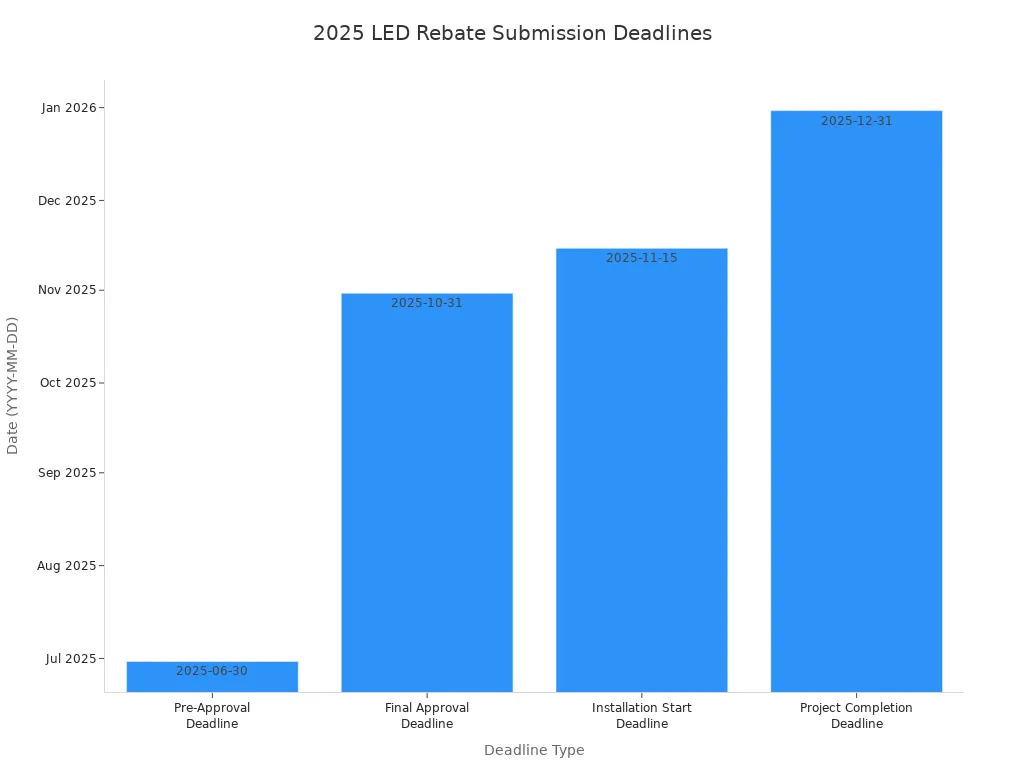
Note: Always look at your program’s website for new info. Deadlines can change if money runs out.
Track Status
You can check your rebate application online. Most programs send emails at each step. Log in to your rebate portal to see your progress. If you use an approved contractor, they can help you check your status. Keep all your papers together. This makes it easy to answer questions or fix problems.
Stay organized and check your email often. Fast replies help you get your rebate sooner.
Maximize Savings
Stack Incentives
You can save more money by using different LED lighting incentives together. Many programs let you use instant discounts, utility rebates, and federal tax credits at the same time. To get the most savings, follow these steps:
Get Pre-Approval Early: Send your pre-approval checklist before August 31, 2025. Plan to change at least half of your old lights to eligible LEDs.
Finish Installation on Time: Finish your lighting upgrade by August 31, 2025. Take photos with location tags of your new lights. Fill out your application form. Some programs want to see plants in rooms to show people use the space.
Choose the Right Programs: Look for instant discounts, prescriptive rebates, and custom programs. These programs give you rewards for saving more energy.
Pick Certified Products: Use ENERGY STAR or DLC-certified LEDs. These products help you get more rebates.
Check Local Utility Offers: Look up your local utility’s programs. Some utilities give extra rewards for smart lighting controls or networked systems.
Tip: Always check the deadlines and rules for each program. Some rebates stop when money runs out.
High-Efficiency Choices
You can save more by picking the most efficient LED products. High-efficiency LEDs use less energy and last longer. Many programs give bigger rebates for advanced lighting, like smart controls or networked systems. ENERGY STAR and DLC-certified products meet strict standards. These products help you get more incentives and lower your energy bills.
Smart lighting controls can help you save even more. Some programs give bonus rebates for these upgrades.
Plan Upgrades
Planning your lighting upgrades early helps you get the most rebates. The table below shows why planning ahead is important:
Benefit/Reason | Description |
|---|---|
Stay ahead of the ban | You avoid the ban on old, inefficient lighting technologies. |
You get the best rebates while they are still available. | |
Capture maximum savings | You save more before incentive programs phase out or funds run out. |
Start your project as soon as you can. Acting early helps you get the highest savings and makes sure you do not miss out on rebates in 2025.
Avoid Mistakes
Missed Deadlines
If you miss a deadline, you might lose your rebate. Many programs have strict dates for forms and inspections. If you forget these dates, you could lose money. Delays can make you start over with new rules. You should plan ahead and keep things organized.
Here is a table that shows mistakes that make people miss deadlines:
Mistake Type | Description |
|---|---|
Timing errors | Custom rebates need good planning. Missing a date can mean no rebate. |
Generic applications | Each utility has different rules. You must change your application to fit or it may be rejected. |
Overlooking follow-ups | Sending in forms is not the last step. You must check back to fix problems. |
Tip: Set reminders for every deadline. Check your email often for news from your rebate program.
Incomplete Forms
You must fill out every part of your rebate form. Many people lose rebates because they forget to finish forms or leave out papers. Programs often want invoices, product details, and before-and-after photos. If you forget any of these, your form can be rejected.
Common mistakes are:
Not finishing all parts of the form
Picking LEDs that do not meet program rules
Applying after your project is done
Missing or incomplete papers, like:
Invoices
Product details
Before-and-after photos
Note: Always check your forms and gather all papers before you send them. This step helps you avoid waiting.
Eligibility Errors
Eligibility rules can be very strict. If you do not follow them, you may not get your rebate. Some common mistakes are missing deadlines, picking the wrong products, or not sending enough papers. Doing the work yourself without following rules can also cause problems.
Watch out for these mistakes:
Using LED products without the right certifications
Not sending all needed records
Installing lights yourself without following program rules
Alert: Always read the program’s eligibility guide. Ask questions if you are not sure about a rule. This step keeps your rebate safe and saves you time.
You can get LED lighting rebates in 2025 by doing these steps:
Step | Duration | Description |
|---|---|---|
Pre-Approval | 4–5 weeks | Get your papers ready and send your application early. |
Installation | 8–13 weeks | Put in approved LEDs and tell if you make changes. |
Final Rebate Submission | 10–12 weeks | Collect your papers and set up inspections for payment. |
⚠️ Act now! Rebates go down by 25% after August 31, 2025. Apply early so you can save more money.
Check LED Lighting Programs from trusted places like SRP, Bright Energy Solutions, and Efficiency Works.
Use instant incentives and bonus deals to save the most.
Ask your contractor to buy from a listed distributor or get a free energy check.
Switching to LEDs with smart controls can lower your energy use by up to 80%. Start your application soon to get the best rebates and pay less for your energy.
FAQ
What types of LED lighting qualify for rebates in 2025?
You need to pick ENERGY STAR or DLC-certified LED products. Most programs let you use bulbs, fixtures, and smart controls. Always look at your program’s approved list before you buy anything.
Can you combine federal, state, and utility rebates?
Yes, you can use these incentives together. You may get instant discounts, utility rebates, and federal tax credits all at once. This way, you save the most money on your lighting upgrade.
How long does it take to get your rebate?
Most rebates take 4 to 12 weeks after you send in your final papers. Some instant incentives give you savings right away when you buy your lights.
Do you need a contractor to install LED lighting for rebates?
Many programs want you to use an approved contractor, especially for instant incentives. Some programs for homes let you put in lights yourself, but always check your program’s rules.
What happens if you miss a rebate deadline?
If you miss a deadline, you might lose your rebate or tax credit. Always set reminders and check your program’s website for updates. Acting early helps you avoid missing out.
See Also
Comparing LED Streetlights And Traditional Lights For Efficiency
Advantages Of LED Street Bulbs For Modern Lighting Solutions
Evaluating ROI And Costs Of Commercial LED Light Bulbs
Exploring Energy Efficient LED Indoor Lighting For Modern Spaces
